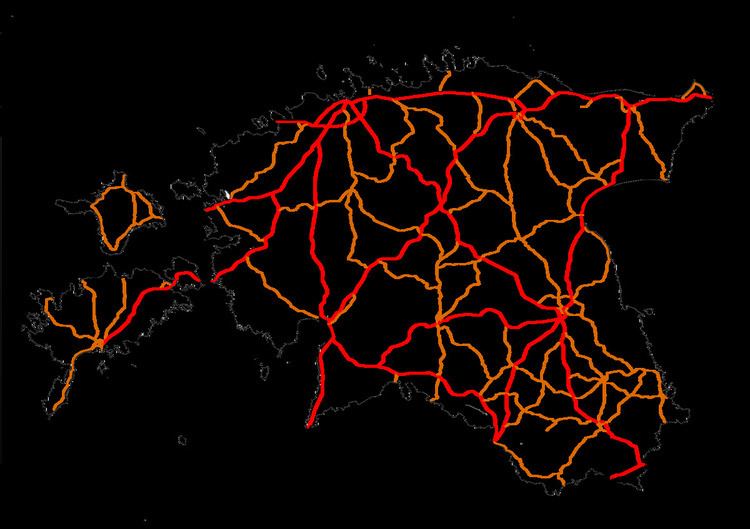 | ||
Highways in Estonia are the main transport network in Estonia. The Estonian national classification includes several classes of highways:
Contents
Other than these, the national road classification includes the following categories which may also be referred to as highways in a general sense, with decreasing order of priority (and applicability of the term highway):
All roads in Estonia are officially marked with the prefix T (followed by 1-3 digits).
The technical classification of highways is as follows:
Main routes
The backbone of the Estonian national route system, national main routes (põhimaanteed) make up a network of 1602 kilometres of road, amounting to 10% of the total road network. The traffic numbers however make up nearly 50% of the Estonian road network's traffic volumes. The highest AADT's are around Tallinn, on the T1 between Loo and Maardu, on the T2 between Tallinn and Jüri, and on the T4 between Laagri and Kanama (the highest AADT in Estonia at 31 A main route is defined as a highway, that connects the capital with other large cities, connects large cities and the capital with major ports, railway points and border crossings. Currently there are 12 separate main routes. The main routes are marked with 1-2 white digits on a red shield. The main roads have no special prefix, as all Estonian roads have the prefix T. The speed limits on Estonian main routes are 110 on 2+2 sections and 90 on regular roads.
The main routes are the only roads with I class highways. The total amount is 147 kilometres, found on the T1, T2, T4 and T11. This number will enlarge significantly with the upgrade of the T11 to I class highway. There are currently no motorways in Estonia, however there are plans to construct one between Kose and Mäo for 2022. Ten main routes are a part of TEN-T, six routes are a part of the International E-road network. The routes E263, E67, E20, E264 and E265 run through Estonia.
The highways are maintained by the Estonian Road Administration outside city limits. Inside cities and towns, the roads are maintained by the city government. The first stationary speed cameras in Estonia were placed on route T2. Currently there are 52 stationary speed cameras on the main routes.
Support routes
Support routes (tugimaanteed) are the second highest classification in the Estonian national route system. They make up a network of 2405 kilometres of road, amounting to 15% of the total road network. A support route is defined as a highway, that connects towns with other towns and main routes. Currently there are 77 separate support routes. The support routes are marked with 2 black digits on a orange shield. The support roads have no special prefix, as all Estonian roads have the prefix T.
European routes
Estonia is a part of the UNECE, and therefore also has numerous E-roads running through it. The E-roads in Estonia form a network on top of the main routes and are usually signposted on all signs. They make up a network of 994 kilometres of road. Currently there are 6 separate European routes in Estonia.
